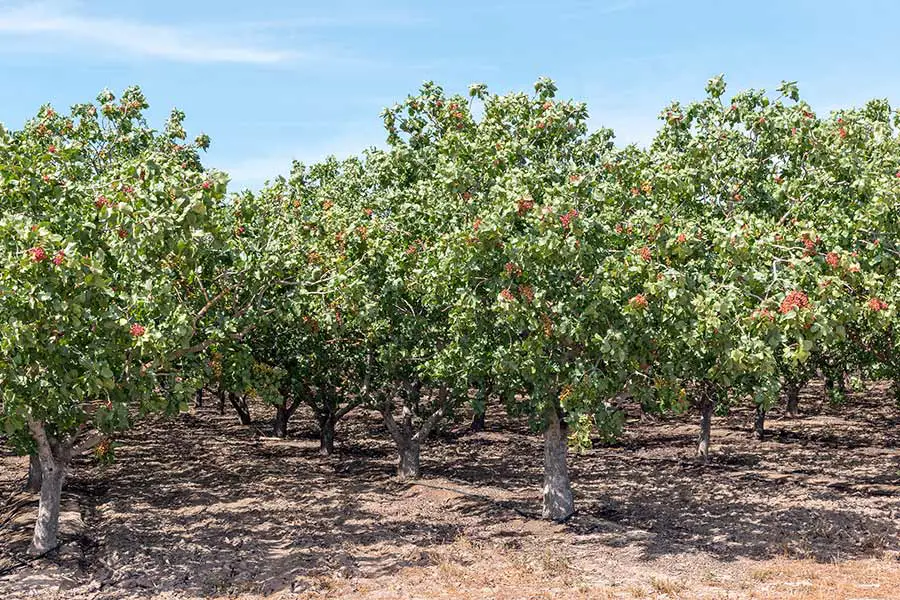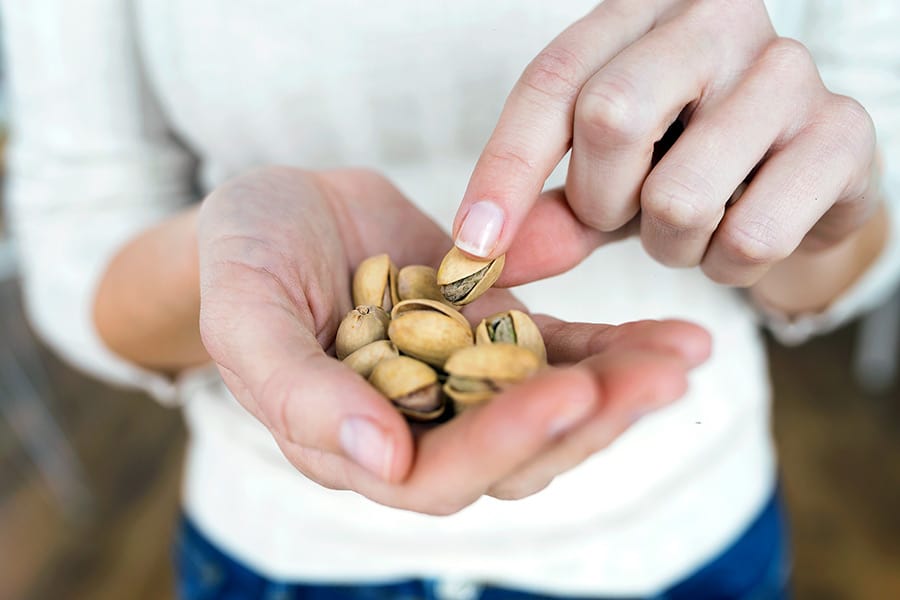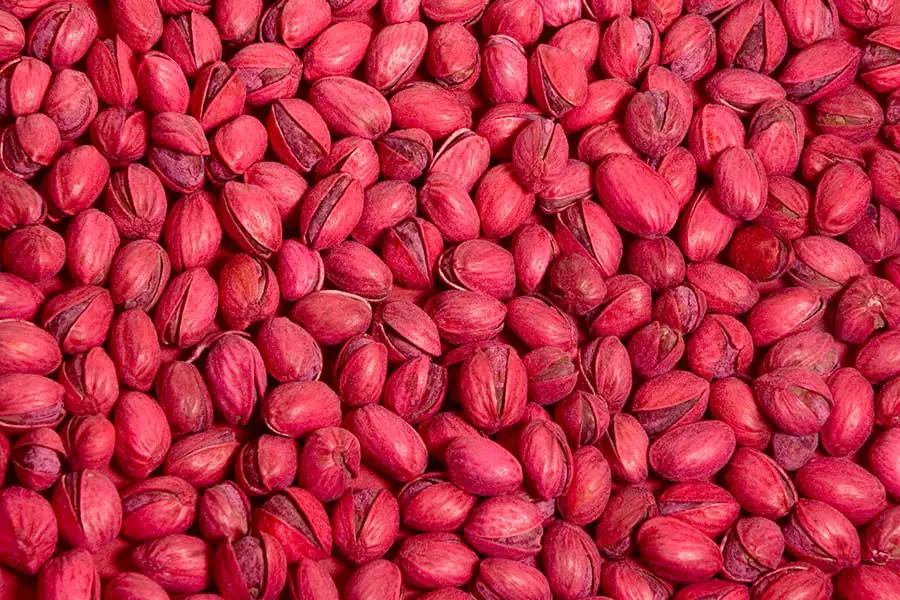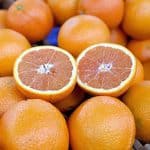
Pistachios are an extremely versatile nut. You can use them for snacking, salad toppings, baked goods, and even a flavor of ice cream. Fitness experts also promote these nuts as a go-to for healthy eating. Since California is a leader in many agricultural products, you might be wondering if pistachios are grown in California?
Pistachios are grown across the State of California. Since pistachio trees require dry conditions, the sunny Golden State is the perfect place for them to grow. Currently, California produces nearly 100% of the total US supply of pistachios.
Adding California pistachios to your diet is both healthy and delicious. This post will cover the history of pistachio production in California, how they are grown, and why they’re so expensive.
Do Pistachios Grow in California?
California is a big agricultural state perfect for growing various crops, including almonds, the grapes of the wine region, delicious citrus, and even pistachios.
Pistachios are a big business in California. Each year, the state produces about 450,000 metric tons of pistachios valued at $1.6 billion. The California pistachio crop accounts for 98 percent of US production, with the remainder coming from New Mexico and Arizona. There are 312,000 planted acres of pistachio trees found in 22 California counties. However, the majority of production (96%) occurs in the San Joaquin Valley in Kern, Madera, Fresno, Kings, and Tulare counties.
The United States is the second-highest consumer of pistachios globally (after China), at 93,000 metric tons consumed each year. However, since California produces nearly five times the amount consumed in the US, a large percentage is exported to countries like China.
Pistachios are actually a seed and not a nut and belong to a family known as “drupes.”
Other drupes include stone fruits such as peaches, cherries, and apricots. Unlike those fruits, pistachios don’t have a juicy flesh that we can eat. Instead, we simply eat the seed inside the “fruit” (or shelled covering).

A fully mature tree can produce about 50 pounds of dried nuts. However, because it takes 15 to 20 years to reach this maturity, pistachio farming requires a lot of advanced planning.
In California, the pistachio harvest is dictated by how quickly the fruit matures and the seeds split open. The trees begin to flower as the weather warms in late March. Following this, the pistachios begin to form on the branches.
The official pistachio harvest typically occurs between late August and early October. First, pistachios are removed from the trees using large machinery that grasps the trunk of the tree and shakes the branches gently. The ripe pistachios then fall into a special basket and are sent to a processing plant, where the outer hull is removed from the shell.
Because pistachios have so many uses, there seems to be no sign of the demand slowing as production is expected to exceed 600,000 metric tons by the year 2026.

Once harvested, pistachios can be consumed in their natural form, or they can be used in other products such as sweet and savory baked goods, salad toppings, mixed in sauces, and making pistachio flavored ice cream. In addition to being delicious tasting, they are very healthy.
What makes pistachios unique is that in their raw form, they must be opened one at a time. As a result, people who eat pistachios tend to consume fewer calories when eating them compared to un-shelled nuts.
Bay Area Answers Fun Fact: Pistachio trees can live up to 300 years if they are grown in an optimal environment.
Other Posts of Interest
- Is California Highway 1 The Same As 101?
- What Is The Most Visited City In California?
- What Is Winter Like In California?
- What Is The California Academy Of Sciences?
Are Pistachios Native to California?
Historically, pistachios were originally found in the Middle East. They’ve been enjoyed as delicacy there for millennia and even been referenced in ancient texts like the Bible. However, pistachios eventually spread to Europe through trade routes and ultimately made their way to the United States.
Pistachios were first imported during the late 1800s because of the growing Middle Eastern population. By 1929, American botanist, William E. Whitehouse, set out to collect pistachios to be brought back and grown in America. He succeeded in successfully growing the pistachio trees but didn’t live long enough for them to produce their first fruit nearly a decade later.

Do Pistachios Open Naturally?
Pistachios are known for their outer shell that requires a bit of effort to open. Fortunately, most pistachios have a natural split that occurs as the fruit matures. Without this split, they are nearly impossible to open without a nutcracker.
Approximately 70 to 90 percent of pistachios split on their own while still on the tree. Then, the remaining pistachios are run through industrial-grade machinery to crack the shell or remove it entirely.
Why are Pistachios Expensive?
Because of the growing and harvesting process, it’s challenging to find perfect-looking pistachios to sell in their raw form, for this reason, pistachios must be hand sorted. As a result, good-quality pistachios are separated from the less aesthetically pleasing ones.
The less desirable pistachios still get used, but they are often chopped or crushed to be used as ingredients and toppings. Because of this labor-intensive process, pistachios rank among the most expensive nuts to produce.
Can You Still Buy Red Pistachios?
Pistachios are infamous for their green color. However, up until the 1980s, it was common to find bright red pistachios for sale. These weren’t a different variety, instead they were dyed by a particular exporter from Syria to make his product more memorable and hide minor imperfections from the harvesting process.
Since most pistachios at the time came from the Middle East, the 1979 Iranian Hostage Crisis led to a shift in the industry. As the United States government moved to block imports from Iran, red pistachios got caught up in the mix. This move opened the opportunity for California to take over as the United States’ major producer. The process of dying pistachios never caught on in the Golden State, so the trend died.

While red pistachios are no longer available in grocery stores, you can still find them online with specialty retailers if you are looking for a nostalgic snack.
Can You Grow Pistachios in Your Backyard?
Pistachio trees are deciduous trees that can grow to a height of 25 to 30 feet. They grow best in hot, dry climates. Pistachio trees don’t need a lot of water and can be watered just once a month.
While the average homeowner can grow a pistachio tree, it comes with challenges. First, you need a lot of patience. It can take 7 to 8 years before the first crop arrives and 15-20 years before it reaches peak production maturity. Also, pistachio trees are not self-pollinating. This factor means that you will need at least one male and one female tree to produce pistachios.
The trees themselves are unisex, so you will need to wait until they produce their first fruit to determine whether it is male or female. To reduce the risk of ending up with a single-gender orchard, you should plan on planting multiple trees. The pollen is transferred entirely by wind, so insects and bees do not play a part.
If you are up for the challenge and have the space needed for several trees, you can try to grow a pistachio tree from raw seeds purchased from a typical grocery store. However, not all seeds will germinate, so you’ll have better luck buying a sapling from a nursery.
Can You Put Pistachio Shells in the Garden?
Snacking on pistachios for even a short amount of time can yield a considerable pile of shells. While most people throw these straight in the garbage, there are some great ways to put them to use around your home and garden.
The most popular use for pistachio shells is mulch for flower and vegetable gardens. The shells contain many nutrients that can benefit the soil when they decompose. They also add a protective layer that can act as a deterrent for pests. For example, squirrels, chipmunks, and raccoons are less likely to dig holes in a garden that is covered with pistachio shells.
In addition to gardening uses, pistachio shells can be used for fire kindling, crafting, and composting.
Enjoying California’s Little Green Treasure
Pistachios have a long and interesting history. Keep this in mind the next time you visit your grocery store. Feel free to pick up a bag of these little green nuts. You’ll be supporting the California economy and getting the incredible health benefits that come with eating pistachios.





